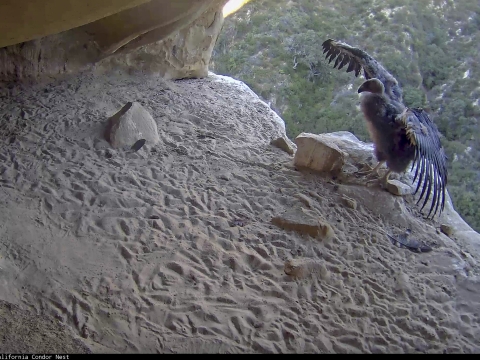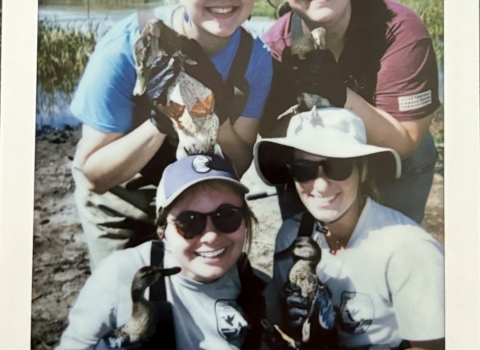An endangered California condor chick has successfully fledged from a cliff-side nest near the U.S. Fish and Wildlife Service’s Hopper Mountain National Wildlife Refuge in Ventura County, California. The young condor took its first short flight on Oct. 14, six months after being raised by its parents in the mountains above Fillmore. Out of the 100 birds in the Southern California flock, 25 have now successfully fledged in the wild.
The chick, known as condor 980, hatched on April 10 and was raised by 9-year-old female condor 563 and 18-year-old male condor 262. The chick’s mother, condor 563, was hatched and raised at the Oregon Zoo before being released at Bitter Creek National Wildlife Refuge in 2011. The chick’s father, condor 262, comes from the first established nest in the wild since the species was re-introduced in 1992.
“What’s fascinating about the dad in this case, is he came not only from the first nest in the wild since the early 90s, but he also came from a three-parent household,” said Molly Astell wildlife biologist with the California Condor Recovery Program. “Two female condors paired with a single male and each laid an egg in the same cavity, which is pretty rare.” To give both eggs the best chance at hatching successfully, biologists brought the egg containing 262 into captivity. In 2002, 262 was released back into the wild at Hopper Mountain National Wildlife Refuge.
“Just a few decades ago, there were zero California condors in the wild, and today, due to successful captive breeding, we have condors taking their first flights in the wild and raising chicks of their own,” said Astell.
So far this nesting season, scientists have recorded seven California condor nests in Southern California. 2018 was a record-breaking season with 12 nests recorded– the highest number of nests across the broadest range ever documented in the area.
“The hatch of chick 262 in 2002 was an important milestone in the California Condor Recovery Program,” said Estelle Sandhaus, director of conservation and research at the Santa Barbara Zoo. “Today, we celebrate the next milestone for condor 262 – his very own chick fledged into the wild. Importantly, this success is part of a population-wide trend: after a period of sustained nest productivity, a quarter of the Southern California condor flock is now wild-fledged.”
Anyone in the world can watch California condors in the wild each nesting season via Cornell Lab of Ornithology’s livestreaming nest cameras.
“For five years running, we’ve been privileged to help share a window into the lives of a condor family nesting in a cliff-side cavity tucked away in the Southern California wilderness,” said Ben Walters, communications specialist for the Cornell Lab of Ornithology. “Watching the adults work together in an attempt to raise a small, downy chick into a lumbering, 20-pound condor is a sight to behold, especially since these magnificent birds were, up until recently, almost lost to us forever.”
Biologists from the U.S. Fish and Wildlife Service and Santa Barbara Zoo will continue to monitor the chick closely.
In California, wild condors are found in the mountains of Monterey, San Benito, San Luis Obispo, Santa Barbara, Ventura, Los Angeles and Kern counties, and most recently in the western foothills of the Sierra Nevada Mountains in Tulare and Fresno counties.
The number of California condors dropped dramatically in the mid-20th century, leading the Service to designate the species as endangered under the Endangered Species Act. By 1982, there were only 22 of the iconic birds left in the wild. Today, due to intensive, ongoing captive breeding and recovery efforts led by the Service in conjunction with multiple public and private partners, the California condor population has grown to around 500 birds worldwide, with just over 200 of those in California and more than half of the population flying free.
The number one cause of death of California condors is lead poisoning. This occurs by condors feeding on carcasses containing lead bullet fragments. When lead ammunition fractures inside the target animal, the fragments of the bullet can spread throughout the tissue of the animal that has been shot. As scavengers, condors unknowingly eat these small fragments and absorb the lead into their systems. Copper bullets, an effective lead alternative, are growing in popularity with the hunting community and minimize collateral wildlife damage as well as ingestion of lead fragments by hunters.
Another threat specific to condor chicks is “micro trash.” Micro trash are small coin-sized items such as nuts, bolts, washers, copper wire, plastic, bottle caps, glass and spent ammunition cartridges. Some condor parents collect these items and feed them to their chick, which can cause serious problems with the chick’s development. While it is not completely understood why this occurs, many biologists believe that the condor parents mistake these items for pieces of bone and shell which provides a source of calcium if fed to the chick.
The U.S. Fish and Wildlife Service’s California Condor Recovery Program is a multi-entity effort to recover the endangered California condor. Partners in condor recovery include the U.S. Forest Service, National Park Service, Bureau of Land Management, U.S. Geological Survey, Arizona Game and Fish Department, California Department of Fish and Wildlife, Utah Department of Fish and Wildlife, the federal government of Mexico, the Yurok Tribe, San Diego Zoo Global, Los Angeles Zoo, Oregon Zoo, Phoenix Zoo, Santa Barbara Zoo, Oakland Zoo, Chapultepec Zoo, The Peregrine Fund, Ventana Wildlife Society, University of California at Santa Cruz, West Virginia University, Colorado State University, Cornell Lab of Ornithology, Western Foundation of Vertebrate Zoology, Santa Barbara Museum of Natural History and the Smithsonian Institution.







